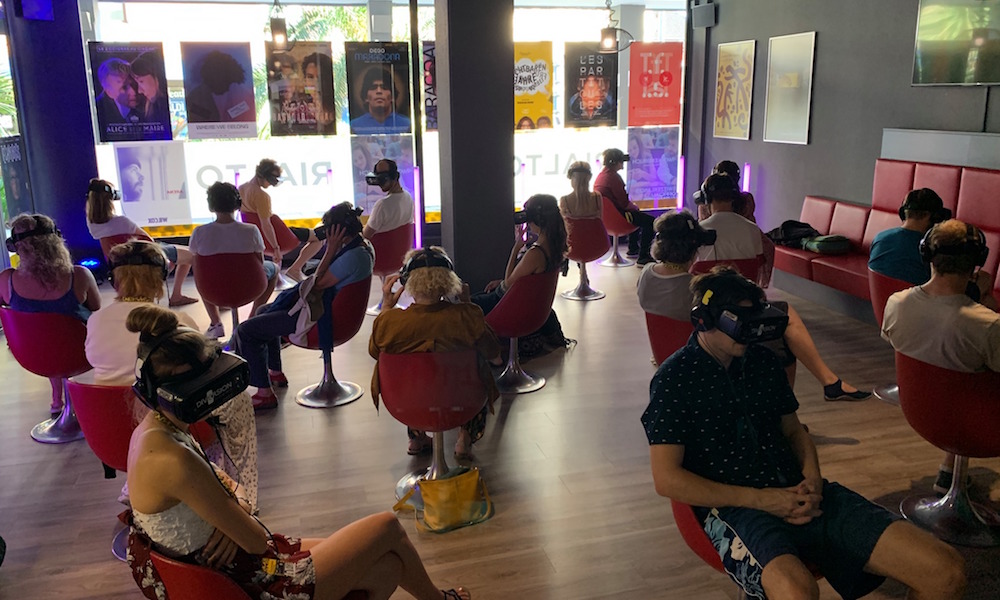This weekend, Glens Falls is rolling out the red carpet for its Fourth Annual Adirondack Film Festival, and with it, comes the North American premiere on Saturday, October 19, of a uniquely produced film set in Saratoga Springs. The 13-minute virtual reality (VR) short, entitled How to Tell a True Immigrant Story, incorporates cutting-edge, 360-degree technology and was filmed right here in the Spa City.
While the film short might have a running time of just 13 minutes, the documentary was a years-long collaboration that tapped a number of local resources. “We couldn’t have done this film without the Saratoga community,” says the film short’s director Aggie Ebrahimi Bazaz, an award-winning Iranian-American documentary filmmaker. “It really was such a deeply collaborative, multi-vocal piece.” That collaboration involved professors and students at Skidmore College, members from Saratoga’s Latinx community and the Saratoga County Economic Opportunity Council (EOC).
The end result is one giant leap forward in the cinematic canon. For the premiere of How to Tell a True Immigrant Story, viewers will don VR headsets and be immersed in the film’s plot, as they get a glimpse into the lives of seasonal migrants working on Saratoga Race Course’s backstretch, as well as at local farms and businesses throughout Saratoga County. The documentary had its world premiere in August at the prestigious 2019 Locarno Film Festival in Switzerland, where it was the first-ever 360-degree VR film entry in the Emerging Filmmakers Competition category. It also received special recognition in September’s Encounters film festival in Bristol, UK.

Why produce the film in such an unorthodox way? Bazaz provides one of the reasons: “In addition to maybe reaching people more deeply because it’s VR, we thought that 360-degree as a spherical space, as a circle, really matched well with the horse track in Saratoga.” To actually shoot the short, Bazaz used a Nikon Keymission 360-degree camera, lent to her through a partnership with the Pubic VR Lab, a media arts center in Brookline, MA that focuses on expanding access to VR and VR training, as well as investing in a greater network of VR creators. (The camera contains two 180-degree lenses that create a composite 360-degree image.) “It’s a bit tedious and it’s an entirely different way of thinking about editing [a film],” says Bazaz. “In a way, the audience becomes the editor just by moving their heads to different parts of the frame.” Bazaz also recorded the film’s audio with a 360-degree (or “ambisonic”) recorder, creating audio shifts and sound perspectives that would translate to viewers wearing a VR headset.
By no means was Saratoga picked at random as the setting of the film. In 2016, Bazaz received a fellowship to the John B. Moore Documentary Studies Collaborative (MDOCS) Storytellers’ Institute at Skidmore, and soon after, befriended Krystle Nowhitney-Hernandez, Deputy Director of the EOC. The two women, who connected over their interest in immigration, began planning a project focusing on Saratoga’s backstretch workers and migrant community. “Saratoga’s a magical place for a lot of people for a lot of different reasons,” says Bazaz. “And talking to people who travel with the horses, they love Saratoga, and they will say that they feel most at home in Saratoga. That’s really good, but I also see some other dynamics that could be better.”
With Nowhitney-Hernandez as her collaborator and executive producer, Bazaz was able to finish the film, in large part, also thanks to support from the EOC and the MDOCS program at Skidmore, which made space for Bazaz and her film crew to stay a whole month on the college’s campus in 2018 while they worked on the project. According to Bazaz, Nowhitney-Hernandez “[served] as a brilliant thought-partner, who was and remains fiercely passionate about the ways that art can foster new perspectives.” She goes on to say that Nowhitney-Hernandez “was willing at every turn, to leverage whatever resources she had in her various positions to facilitate the successful execution of our collectively-imagined projects while also ensuring their adherence to our core values.” A handful of Skidmore MDOCS students—including Emily Rizzo, Eleanor Green and Eleuterio Martinez Ramirez, all class of 2018—and MDOCS Directors Jordana Dym and Adam Tinkle also helped to fund, produce and bring the film to fruition.
Overall, Bazaz says that the reaction to How to Tell a True Immigrant Story has been positive. “VR researchers, in particular, have really connected with it for its poeticism and its experimental approach, because we’re really breaking apart the 360-degree space,” says Bazaz. Besides getting to watch her film’s big North American premiere this Saturday in Glens Falls, Bazaz will also lead a panel discussion on documentary and community collaborations at Skidmore on Monday, October 21, along with collaborators Nowhitney-Hernandez, Rizzo and community collaborator Ana Cruz.
Tickets are still available for the premiere here, though VIP tickets are required to access the festival’s VR lounge. The film short will also be screened at Caffè Lena on Tuesday, October 29, in partnership with the Saratoga Immigration Coalition’s quarterly In Their Own Words storytelling series.


